What Is Biomechanical Analysis and Why Does It Matter?
Biomechanical analysis is the scientific study of how your body moves, with particular focus on how your feet and ankles function during walking, running, and standing. Your feet are the foundation of your entire body, and problems with foot mechanics can create a chain reaction of issues throughout your legs, hips, and back.
At Annapolis Foot & Ankle Center, our board-certified podiatrists use advanced gait analysis technology and biomechanical assessment to identify the root causes of not just foot pain, but also knee, hip, and back problems that originate from faulty foot mechanics. Understanding how your feet move is crucial for effective treatment and prevention of injuries throughout your kinetic chain.
How Do Foot Problems Affect Your Entire Body?
The human body is an interconnected kinetic chain, where dysfunction in one area can cause compensatory problems elsewhere. When your feet don't function properly, your body makes adjustments that can lead to pain and injury in unexpected places.
The Kinetic Chain Connection:
Foot to Ankle: Abnormal foot motion directly affects ankle joint positioning and function, leading to instability, impingement, and arthritis.
Ankle to Knee: Poor ankle mechanics alter leg rotation and knee tracking, contributing to patellofemoral pain, IT band syndrome, and meniscus problems.
Knee to Hip: Compensatory knee movements change hip mechanics, causing hip impingement, bursitis, and gluteal weakness.
Hip to Back: Hip dysfunction affects pelvic alignment and spinal mechanics, leading to lower back pain, muscle imbalances, and postural problems.
Common Conditions Caused by Foot Biomechanical Problems:
- Knee pain - Patellofemoral syndrome, runner's knee, IT band syndrome
- Hip pain - Hip impingement, trochanteric bursitis, piriformis syndrome
- Lower back pain - Lumbar strain, SI joint dysfunction, postural problems
- Achilles problems - Tendonitis, ruptures from compensatory stress
- Shin splints - Medial tibial stress syndrome from overpronation
- Stress fractures - Overuse injuries from poor shock absorption
Learn more about our sports injury treatment services.
Understanding Normal Foot and Ankle Biomechanics
The Gait Cycle Explained:
Normal walking involves a complex sequence of coordinated movements. Understanding this process helps identify where problems occur.
Heel Strike (Initial Contact):
- Heel contacts ground - First point of contact
- Ankle dorsiflexed - Foot angled upward
- Foot supinated - Rigid lever for stability
- Shock absorption begins - Forces dissipated through leg
Loading Response (Foot Flat):
- Full foot contact - Entire sole touches ground
- Pronation occurs - Foot becomes flexible adapter
- Weight acceptance - Body weight transfers onto leg
- Shock absorption continues - Impact forces managed
Midstance (Single Limb Support):
- Body passes over foot - Center of gravity advances
- Maximum pronation - Peak foot flexibility
- Stability required - Muscles work to maintain balance
- Energy conservation - Efficient forward progression
Terminal Stance (Heel Rise):
- Heel lifts off - Weight shifts to forefoot
- Supination begins - Foot becomes rigid lever
- Propulsion phase - Forward momentum generated
- Energy storage - Elastic recoil in tendons
Pre-Swing (Toe Off):
- Toes push off - Final propulsive force
- Maximum supination - Foot rigid for push-off
- Energy release - Stored energy propels body forward
- Swing phase begins - Foot leaves ground
Key Biomechanical Concepts:
Pronation and Supination:
- Pronation - Foot flattens and becomes flexible for shock absorption
- Supination - Foot arches and becomes rigid for stability and propulsion
- Normal transition - Smooth change between these positions
- Timing importance - When these motions occur in gait cycle
Center of Pressure Movement:
- Heel contact - Pressure starts at heel
- Lateral border - Pressure moves along outside of foot
- Forefoot transition - Pressure shifts to ball of foot
- Big toe push-off - Final pressure at great toe
Common Biomechanical Abnormalities
Overpronation (Excessive Pronation):
What is Overpronation?
The foot pronates too much or for too long during the gait cycle, causing the arch to collapse excessively and the foot to remain flexible when it should become rigid.
Causes of Overpronation:
- Flat feet - Collapsed or absent arch structure
- Flexible flatfoot - Arch collapses under weight
- Posterior tibial tendon dysfunction - Weakened arch support
- Leg length discrepancy - Compensatory mechanism
- Hip weakness - Poor proximal control
- Tight calf muscles - Limited ankle motion
Problems Caused by Overpronation:
- Plantar fasciitis - Arch strain and heel pain
- Posterior tibial tendonitis - Arch support tendon inflammation
- Knee valgus - Inward knee collapse
- IT band syndrome - Lateral knee pain
- Hip internal rotation - Hip and back compensation
Learn about our flat foot treatment options.
Oversupination (Excessive Supination):
What is Oversupination?
The foot doesn't pronate enough or supinates too much, remaining rigid when it should be flexible for shock absorption.
Causes of Oversupination:
- High arches - Rigid foot structure
- Cavus foot deformity - Excessively arched foot
- Ankle stiffness - Limited dorsiflexion
- Previous injuries - Scar tissue and stiffness
- Neurological conditions - Muscle imbalances
Problems Caused by Oversupination:
- Stress fractures - Poor shock absorption
- Ankle sprains - Increased lateral instability
- Peroneal tendonitis - Lateral tendon overuse
- Knee varus - Outward knee deviation
- Hip and back stress - Compensatory problems
Functional Hallux Limitus:
Definition: Limited big toe motion during walking, even though passive range of motion may be normal.
Impact on Gait:
- Reduced push-off power - Less efficient propulsion
- Compensatory motions - Hip hiking, early heel rise
- Increased forefoot pressure - Overloading lesser toes
- Altered knee mechanics - Changed loading patterns
Clinical Assessment Tools:
Static Biomechanical Evaluation:
- Foot posture assessment - Arch height and alignment
- Joint range of motion - Flexibility and stiffness testing
- Muscle strength testing - Identifying weakness patterns
- Postural analysis - Overall body alignment
- Leg length measurement - Structural asymmetries
Dynamic Function Tests:
- Single leg stance - Balance and stability assessment
- Heel rise test - Posterior tibial tendon function
- Too many toes sign - Foot alignment evaluation
- Jack's test - Windlass mechanism function
- Functional movement screening - Overall movement quality
Biomechanical Treatment Approaches
Custom Orthotics and Biomechanical Control:
Our custom orthotics are designed based on comprehensive biomechanical analysis:
Functional Foot Orthoses:
- Motion control - Limit excessive pronation or supination
- Arch support - Maintain optimal foot positioning
- Pressure redistribution - Reduce high-pressure areas
- Shock absorption - Improve impact management
- Propulsion enhancement - Optimize push-off mechanics
Accommodative Orthoses:
- Cushioning - Reduce pressure and pain
- Deformity accommodation - Work around fixed problems
- Ulcer prevention - Protect high-risk areas
- Comfort enhancement - Improve weight distribution
Sport-Specific Orthoses:
- Activity-specific design - Tailored for sport demands
- Performance enhancement - Optimize biomechanics for sport
- Injury prevention - Reduce sport-specific injury risk
- Recovery support - Aid in rehabilitation process
Physical Therapy and Exercise Prescription:
Strength Training Programs:
- Intrinsic foot muscles - Arch support and toe function
- Posterior tibial strengthening - Medial arch control
- Hip stabilizer training - Proximal control improvement
- Core strengthening - Overall stability enhancement
- Calf muscle conditioning - Propulsion and shock absorption
Flexibility and Mobility Work:
- Calf stretching - Improve ankle dorsiflexion
- Plantar fascia mobilization - Reduce arch tightness
- Hip flexor stretching - Address compensatory tightness
- Joint mobilization - Restore normal joint motion
- Fascial release techniques - Reduce tissue restrictions
Balance and Proprioception Training:
- Single leg balance - Improve stability and control
- Dynamic balance activities - Functional movement training
- Perturbation training - Reaction time improvement
- Sensory integration - Enhanced body awareness
Footwear Modifications and Recommendations:
Shoe Selection Criteria:
- Heel counter support - Rear foot stability
- Appropriate heel height - Optimal biomechanics
- Sole flexibility - Allow normal foot motion
- Toe box dimensions - Accommodate foot shape
- Arch support features - Built-in biomechanical control
Shoe Modifications:
- Heel lifts - Address leg length discrepancies
- Metatarsal pads - Redistribute forefoot pressure
- Rocker sole modifications - Improve roll-over characteristics
- Heel posting - Control rear foot motion
- Toe spring adjustments - Optimize toe-off mechanics
Learn more about proper footwear selection.
Sports Performance and Biomechanics
Sport-Specific Biomechanical Analysis:
Running Biomechanics:
- Foot strike pattern - Heel, midfoot, or forefoot strike
- Cadence analysis - Steps per minute optimization
- Ground contact time - Efficiency measurement
- Vertical oscillation - Energy waste assessment
- Pronation velocity - Rate of foot motion
Cutting and Pivoting Sports:
- Landing mechanics - Injury risk assessment
- Change of direction - Efficiency and safety
- Single leg stability - Control during movement
- Deceleration patterns - Force absorption capability
- Reactive agility - Response to external stimuli
Jumping and Landing Analysis:
- Take-off mechanics - Power generation assessment
- Flight phase analysis - Body positioning
- Landing strategy - Impact absorption technique
- Ground reaction forces - Peak force measurements
- Recovery time - Return to ready position
Performance Enhancement Strategies:
- Biomechanical optimization - Improve movement efficiency
- Injury prevention - Identify and address risk factors
- Recovery enhancement - Reduce fatigue and overuse
- Technique refinement - Sport-specific skill improvement
- Equipment optimization - Footwear and orthotic selection
Pediatric Biomechanics and Development
Normal Foot Development:
Age-Related Changes:
- Birth to 2 years - Flat foot appearance normal
- 2-6 years - Arch development begins
- 6-10 years - Adult foot shape emerges
- 10+ years - Biomechanics approach adult patterns
Developmental Milestones:
- Walking initiation - Typically 12-15 months
- Mature gait pattern - Develops by age 7
- Single leg balance - Improves with age
- Sports participation - Readiness varies by development
Learn about our pediatric foot care services.
Common Pediatric Biomechanical Issues:
- In-toeing - Pigeon-toed walking pattern
- Out-toeing - Duck-footed walking pattern
- Toe walking - Persistent forefoot walking
- Flexible flatfoot - Arch collapse with weight bearing
- Growing pains - Activity-related leg pain
Technology Integration in Clinical Practice
Data Collection and Analysis:
Objective Measurements:
- Force platform data - Ground reaction force quantification
- Pressure distribution maps - Visual representation of loading
- Joint angle calculations - Precise movement measurement
- Timing parameters - Gait phase duration analysis
- Symmetry indices - Left-right comparison metrics
Report Generation:
- Comprehensive analysis - Detailed biomechanical assessment
- Visual presentations - Graphs and images for patient education
- Treatment recommendations - Evidence-based intervention plans
- Progress tracking - Before and after comparisons
- Outcome measures - Quantified improvement documentation
Patient Education and Understanding:
- Visual demonstrations - Show abnormal movement patterns
- Comparative analysis - Normal vs. abnormal examples
- Treatment rationale - Explain why specific treatments are recommended
- Progress visualization - Show improvement over time
- Home exercise guidance - Video-based instruction
Research and Evidence-Based Practice
Current Research Areas:
- Orthotic effectiveness - Evidence for biomechanical interventions
- Injury prediction - Using gait analysis to identify risk
- Performance optimization - Biomechanics and athletic performance
- Technology validation - Comparing measurement systems
- Treatment outcomes - Long-term follow-up studies
Clinical Applications of Research:
- Evidence-based protocols - Research-supported treatments
- Outcome prediction - Probability of treatment success
- Risk stratification - Identifying high-risk patients
- Treatment optimization - Personalized intervention strategies
- Quality assurance - Standardized assessment procedures
Frequently Asked Questions About Biomechanics and Gait Analysis
A: Your feet are the foundation of your body's kinetic chain. When foot mechanics are abnormal, your body compensates with changes in ankle, knee, hip, and back function, often leading to pain in these areas.
A: Gait analysis typically includes walking on pressure-sensitive plates or treadmills while being recorded. We analyze your foot pressure patterns, joint movements, and timing to identify abnormalities.
A: Custom orthotics are highly effective for many biomechanical issues, but success depends on proper diagnosis and orthotic design. Gait analysis helps ensure we create the right device for your specific needs.
A: Initial improvements may be noticed within 2-4 weeks of starting treatment, but full adaptation to orthotics or significant strength changes may take 3-6 months.
A: While structural problems can't always be "cured," most biomechanical issues can be effectively managed with proper treatment, significantly reducing symptoms and preventing complications.
Why Choose Annapolis Foot & Ankle Center for Biomechanical Analysis?
Our Advanced Assessment Capabilities:
- Board-certified podiatric surgeons - Specialized biomechanical training
- Advanced gait analysis technology - State-of-the-art measurement systems
- Comprehensive evaluation - Static and dynamic assessment
- Evidence-based treatment - Research-supported interventions
- Multidisciplinary approach - Coordinated care with physical therapists
- Custom orthotic laboratory - On-site device fabrication
Specialized Services:
- Sports performance analysis - Athletic biomechanical optimization
- Injury prevention screening - Risk factor identification
- Pediatric biomechanics - Developmental assessment and treatment
- Post-surgical analysis - Recovery and rehabilitation monitoring
- Occupational biomechanics - Work-related movement analysis
- Research participation - Access to latest developments
Discover the Root Cause of Your Pain
Don't just treat symptoms - address the underlying biomechanical causes of your foot, knee, hip, or back pain. Our comprehensive gait analysis and biomechanical assessment can reveal the true source of your problems and guide effective treatment.
Schedule your biomechanical evaluation today by calling 410-266-7666 or contact us online. Discover how proper foot function can improve your entire body's performance.
Serving athletes and active individuals throughout Annapolis, Anne Arundel County, Prince George County, Calvert County, St. Mary's County, Kent Island, and the Eastern Shore with advanced biomechanical analysis for over 30 years.
Related Services:
- Custom Orthotics and Foot Support
- Sports Injury Treatment and Prevention
- Flat Foot Treatment and Correction
- Heel Pain and Plantar Fasciitis
- Pediatric Foot Development







